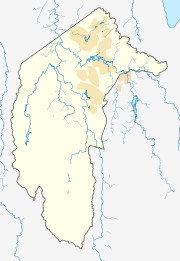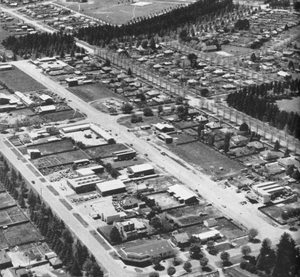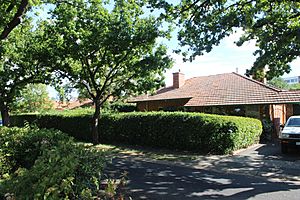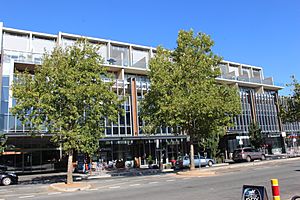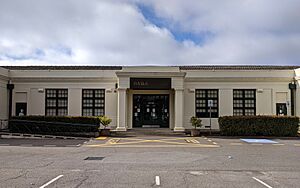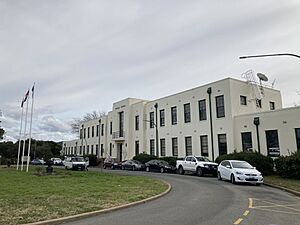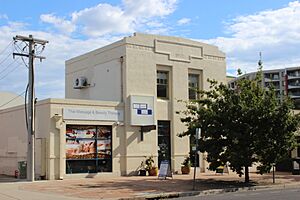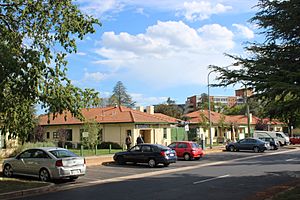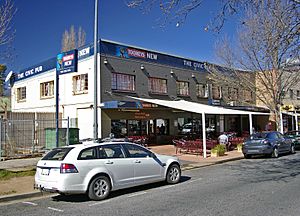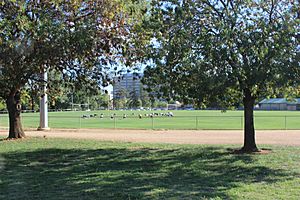Braddon, Australian Capital Territory facts for kids
Quick facts for kids BraddonCanberra, Australian Capital Territory |
|||||||||||||||
|---|---|---|---|---|---|---|---|---|---|---|---|---|---|---|---|
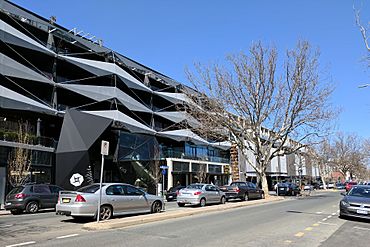
Lonsdale Street in September 2017
|
|||||||||||||||
| Population | 6,383 (2021 census) | ||||||||||||||
| • Density | 4,560/km2 (11,800/sq mi) | ||||||||||||||
| Established | 1922 | ||||||||||||||
| Gazetted | 20 September 1928 | ||||||||||||||
| Postcode(s) | 2612 | ||||||||||||||
| Elevation | 576 m (1,890 ft) | ||||||||||||||
| Area | 1.4 km2 (0.5 sq mi) | ||||||||||||||
| Location |
|
||||||||||||||
| District | North Canberra | ||||||||||||||
| Territory electorate(s) | Kurrajong | ||||||||||||||
| Federal Division(s) | Canberra | ||||||||||||||
|
|||||||||||||||
Braddon is a lively suburb located in the inner north of Canberra, Australian Capital Territory, Australia. It's right next to the main city area, known as the Canberra CBD.
Braddon is one of Canberra's oldest suburbs, even though Canberra itself is a fairly young city. It was first settled in 1922 and officially named in September 1928. It used to be home to Canberra's first light-industrial area, where smaller factories and workshops were located. Today, much of this area has been updated with new buildings for entertainment and homes. Many older houses have also been replaced with modern apartments. Braddon is now Canberra's most crowded suburb, with lots of people living close to the city.
Contents
Braddon's History
Building started in the Braddon Garden City area in 1921 and 1922. This special area was designed by Walter Burley Griffin, who planned Canberra. It was the only part of his residential designs that was fully built. The suburb was officially named in September 1928.
Braddon got its name from Edward Braddon. He was an important politician who helped write the Australian Constitution. Streets in Braddon are named after Aboriginal words, famous politicians, and early Australian pioneers.
In the 1920s, Braddon became home to Canberra's first light-industrial area. This area later became known for car repair shops and dealerships. Over time, these businesses moved to other suburbs. Recently, the old industrial area has been transformed into a fun place with new restaurants, shops, and apartments. Most of the older houses in Braddon have also been replaced with modern apartment buildings.
Special Heritage Places
Some areas in Braddon are protected because they are historically important. These include:
- The Braddon Garden City area, which is a special example of early city planning.
- Gorman House, a historic building now used for arts.
- Hotel Ainslie, also known as Mercure Canberra.
- Ainslie Primary School.
- The Whitley House, a unique modern house built in 1939.
- Haig Park, a large park with many trees.
- Northbourne Oval, an old sports ground.
- The former Coggan's Bakery, a historic building on Mort Street.
What Braddon is Like Today
Braddon has a busy commercial area, mainly along Mort and Lonsdale streets. These streets are full of cool places like small art galleries, cafes, and trendy shops. You can find unique gifts, clothes, and places to eat and drink. In the past, this area had many car dealerships. Now, some of these are being replaced by tall apartment buildings with shops on the ground floor. Braddon also has popular pubs and office buildings.
Away from the main shopping streets, many old houses have been replaced by apartment buildings. These apartments are popular because they are so close to the city center. The old Fenner Hall, a student residence for the Australian National University, is now the Canberra Accommodation Centre. Braddon is a mix of different people, including young professionals, students, and some people who live in public housing. You can still find some traditional family homes where Braddon meets Ainslie and Dickson.
Cool Places in Braddon
Ainslie School
Ainslie School is one of Canberra's oldest schools, opening in 1927. It was the first official act of Prime Minister Stanley Bruce when he arrived in Canberra. The building is special because it has its original design and features from the Art Deco style. It was also one of the first schools in Australia planned with a library, a lecture room, and a sewing room. The original building became an infants school in 1938. Later, it was used by Questacon and the School Without Walls. Today, it is the Ainslie Arts Centre, a place for creative activities.
Allawah Court and Currong Apartments
These apartment buildings were built in the 1950s. They helped house government workers who moved to Canberra. Allawah Court had 114 apartments, and Currong Apartments had 212. They were designed in a modern style, similar to buildings in Europe after World War II. Even though they were important for housing, these buildings were demolished in 2017 to make way for newer, more modern homes.
Braddon Garden City Heritage Precinct
This special area, bordered by Donaldson, Elimatta, Batman, and Currong streets, is protected for its history. It's a great example of an early 20th-century "Garden City" design. This means it was planned to combine city living with green spaces. The first houses here were built in 1921-1922. They provided urgent housing for government workers and builders. This area is the only fully completed residential design by Canberra's original planner, Walter Burley Griffin.
The Former Coggan's Bakery
The old Coggan's Bakery on Mort Street (which faces Elouera Street) is a historic building. It shows how Canberra was planned and developed in the 1920s. It was part of the early plan for Braddon as a light-industrial area. The Heritage Council says it's the most unique historical building in Braddon's old industrial zone.
Gorman House Arts Centre
The Gorman House Arts Centre is a beautiful old building now used for arts and culture. It's home to many of Canberra's main arts groups, smaller art clubs, and individual artists.
At the centre, you can find performance spaces, dance studios, workshops, a gallery, and artist studios. There are also meeting rooms and a weekend market where you can buy art, crafts, and second-hand items. Braddon's theatres and galleries, like the Bogong Theatre and Canberra Youth Theatre, are located here.
Haig Park
Haig Park is a long park that runs along both sides of Northbourne Avenue in Braddon and Turner. It has fourteen rows of trees planted to block wind and provide shelter. It's listed on the ACT Heritage register because of its importance.
Hotel Ainslie (Mercure Canberra)
The Hotel Ainslie, now called the Mercure Canberra, was built in 1926-1927. It was originally a government hostel to house public servants moving to Canberra. Since 1928, it has been a hotel. The outside of the original building, the front garden, and the central courtyard are all heritage listed. This means they are protected because of their historical value.
Lonsdale Street
Lonsdale Street used to be an industrial area with car yards and factories. But in recent years, it has become a very cool and trendy place. It's now the main commercial hub of Braddon. Lonsdale Street has shops selling items by local Canberra designers, stylish Australian clothes, imported shoes, and handmade gifts. You'll also find a mix of restaurants, bakeries, bike shops, food trucks, and hairdressing salons.
During the Summernats car festival, Lonsdale Street hosts an unofficial street parade called the Lonsdale Street Cruise. All kinds of cars participate, and many people come to watch. In 2013, The Sydney Morning Herald even called Lonsdale Street Canberra's 'hippest hood'!
Merici College
Merici College is a private Catholic high school just for girls. It teaches students from Year 7 to Year 12.
Northbourne Oval
Northbourne Oval was created in 1925, making it the oldest enclosed sports oval in North Canberra. It's listed by the ACT Heritage Council. Since 2020, the Canberra Raiders rugby league team has used it as their training ground.
Places of Worship
Braddon is home to several churches:
- St Patrick's Catholic Church, built in 1935.
- St Columbus Uniting Church
- Salvation Army Canberra City Temple
- St Mary's Catholic Church
- Sisters of Mercy
- Australian Episcopal Conference
People of Braddon
In 2021, Braddon had 6,383 people living there. This is a big jump from 3,574 people in 2006! The average age of people in Braddon is 30, which is younger than the average for Canberra (35) and Australia (38).
Many people in Braddon work as professionals (45.3%). A large number (25.4%) work in central government jobs. Most people (61.5%) were born in Australia. Other common birthplaces include China (6.8%), England (3.5%), and India (3.0%). Most people (63.6%) speak only English at home. Other languages spoken include Mandarin (8.1%) and Cantonese (1.8%).
About 60.4% of homes in Braddon are rented. Only a small number (4.9%) are separate houses. Most homes (80.7%) are flats, units, or apartments. In 2012, Braddon was named one of the 'hippest places to live in Australia'.
Trees and Plants
Braddon has many different types of trees, mostly non-native ones like cedar, ash, oak, and pine. However, there are also many eucalyptus trees, especially around the edges of the suburb and in Haig Park. Most streets in Braddon have rows of mature, beautiful trees. Torrens Street, with its oak trees, is a great example of a "garden city" street.
It's important to know that poisonous mushrooms, like "death caps," can grow in Braddon, especially near oak trees. So, be careful and never eat wild mushrooms!
Street Names in Braddon
The streets in Braddon are named after Aboriginal words, important politicians, and pioneers.
- Ainslie Avenue: Named for James Ainslie.
- Batman Street: Named for John Batman.
- Burra Place: An Aboriginal word meaning 'wait' or 'stop'.
- Chapman Street: Named for Austin Chapman.
- Coolac Place: An Aboriginal word meaning 'native bear'.
- Cooyong Street: An Aboriginal word meaning 'bandicoot'.
- Donaldson Street: Named for Stuart Donaldson.
- Doonkuna Street: An Aboriginal word meaning 'rising ground'.
- Dooring Street: An Aboriginal word meaning 'the bark of trees'.
- Elder Street: Named for Thomas Elder.
- Elimatta Street: An Aboriginal word meaning 'my home'.
- Elouera Street: An Aboriginal word meaning 'pleasant place'.
- Farrer Street: Named for William James Farrer.
- Fawkner Street: Named for John Pascoe Fawkner.
- Gilchrist Gardens: Named for John Gilchrist, a Canberra Town Planner.
- Girrahween Street: An Aboriginal word meaning 'place of flowers'.
- Gooreen Street: An Aboriginal word meaning 'wind'.
- Helemon Street: An Aboriginal word meaning 'a shield'.
- Henty Street: Named for Edward Henty.
- Ijong Street: An Aboriginal word meaning 'water'.
- Ipima Street: An Aboriginal word meaning 'two'.
- Limestone Avenue: Named for 'Limestone Plains', an early name for Canberra.
- Lonsdale Street: Named for William Lonsdale.
- Mort Street: Named for Thomas Sutcliffe Mort.
- Northbourne Avenue: Combines 'north' and 'bourne' (an old French word for boundary).
- Sulman Gardens: Named for John Sulman.
- Torrens Street: Named for Robert Torrens.
- Wakefield Avenue: Named for Edward Gibbon Wakefield.
- Wise Street: Named for Bernhard Ringrose Wise.
Braddon's Rocks
The ground in Braddon is mostly made of soft rocks called shales from the Canberra Formation. These are covered by newer soil and gravel. This shale is the "limestone" that gave Canberra its original name, "Limestone Plains."


